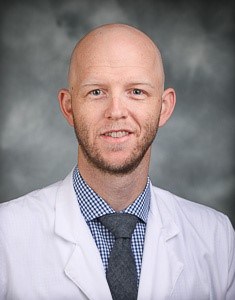“Lynch syndrome (LS) is the most common hereditary cause of uterine cancer,” explains Daniel Spinosa, MD. “Understanding whether a uterine cancer is caused by LS or not has prognostic and therapeutic implications for the patient as well as for the patient’s family. The Society for Gynecologic Oncology recommends, screening for LS, but it is not prescriptive about how that screening should be done, allowing for both age- and/or risk-based screening or universal screening.”
For a paper published in Gynecologic Oncology, Dr. Spinosa and colleagues aimed to determine the feasibility and effectiveness of a quality improvement initiative (QI) to adopt universal screening for LS in patients with uterine cancer at an institution that previously employed age-based screening. “The main impetus for this QI project was the difficulty in reliably applying age-based screening, whereas universal screening is, in many ways, more logistically facile,” he says. “A secondary line of inquiry was whether universal screening was more effective, but that was not necessarily the motivating factor, as either screening approach is within the guidelines.”
Nearly 100% Compliance With Universal Screening
Prior to the initiative, tumors of patients with uterine cancer diagnosed at age 60 or younger were screened for mismatch repair deficiency (MMR) and microsatellite instability (MSI). The QI process change model adopted universal testing for all uterine cancer specimens and implemented provider training, standardized documentation, and enhanced use of the electronic medical record (EMR). The researchers compared screening rates, results of screening, follow-up of abnormal results, and final diagnoses from the pre- and post-implementation periods.
To change provider behavior in favor of universal screening, Dr. Spinosa and the study team:
- offered a provider training and education curriculum,
- updated provider documentation to include a field for whether genetic screening was performed and, if so, the results, and
- updated pathology documentation to include screening results.
“We found that institutional compliance with age- and/or risk-based screening was suboptimal, with less than 60% of patients younger than 60 receiving screening, despite the recommendations of the institutional policy,” Dr. Spinosa says. “Compliance with universal screening was nearly 100%, and the interventions we used to improve that compliance would be easy to implement by nearly any healthcare system. We greatly reduced the opportunity for provider error/oversight by strictly standardizing the process and adding documentation checks to encourage compliance. Age-based screening, even if perfectly executed, would have missed multiple hereditary cancer syndromes that were diagnosed after implementation of universal screening.”
Universal Screening Removes Chance to Overlook Protocol
One of the study’s secondary aims was to examine the results of screening in the pre-implementation and post-implementation cohorts (Figure). “A higher percentage of patients in the post-implementation group had abnormal screening results (not all of which were hereditary), got referred to genetic counseling, and were diagnosed with hereditary cancer syndromes when compared with the pre-implementation group,” he says.
Although universal screening may seem more challenging to physicians than target screening, Dr. Spinosa emphasizes that this is not the case. “Universal screening is actually easier to comply with, as it removes an opportunity for busy providers to overlook a protocol,” he says. “Our data also point toward, but do not definitively establish, universal screening as being more effective than age- and/or risk-based screening.”
Dr. Spinosa expresses a desire for future research comparing the cost-effectiveness of universal screening with that of age- and/or risk-based screening. “We would also like to see interventions implemented at other institutions, or for other screening protocols at our institution, to further validate their broad applicability,” he adds.


 Physician's Weekly Admin
Physician's Weekly Admin